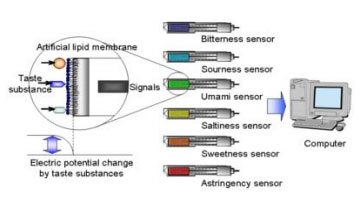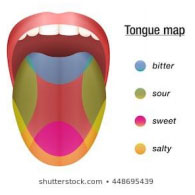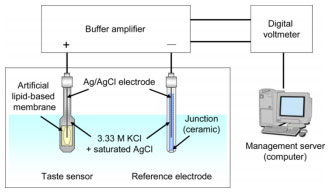 Sensors are devices that receive stimuli commonly detected by the five senses of sight, hearing, touch, smell and taste. They can be categorized into two types: Physical sensors and Chemical sensors. A physical sensor is a device that detects physical quantities, including light, pressure and sound whereas a chemical sensor detects chemical substances and represents a certain quality e.g a pH meter is a chemical sensor.[1]
Sensors are devices that receive stimuli commonly detected by the five senses of sight, hearing, touch, smell and taste. They can be categorized into two types: Physical sensors and Chemical sensors. A physical sensor is a device that detects physical quantities, including light, pressure and sound whereas a chemical sensor detects chemical substances and represents a certain quality e.g a pH meter is a chemical sensor.[1]
Response principle : Scientists earlier thought that the taste buds that detect different kinds of tastes are located in specific areas of the tongue .Now it is proved that each taste bud can detect all tastes (sweet, sour, bitter, salty and umami). A taste sensor is required to exhibit global selectivity so that it responds consistently to the same taste similarly to the human tongue. After years of research, Japan and Sweden have successfully developed taste sensors based on an artificial lipid membrane.

Fig. Response principle of taste sensors
The lipid in the taste sensor interacts with various taste materials via electrostatic and
hydrophobic interactions, which causes a change in potential of the lipid membrane. The
change is detected by a computer to provide a sensor output.
Source:
Representational Images:

Different parts of the tongue taste

Block Diagram